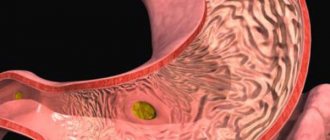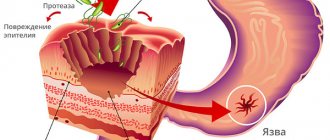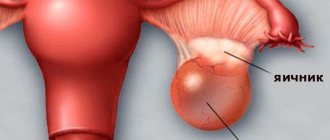Causes of chronic endocervicitis
Chronic endocervicitis is an inflammatory disease that constantly progresses. The pathological process develops in the mucous membrane of the cervical canal of the uterus against the background of untreated acute inflammation caused by infection.
The disease occurs under the influence of:
- pathogens of STIs. The most common cause of inflammation is chlamydia. The disease can also be triggered by herpes simplex virus, gonococci, HPV, ureaplasma, mycoplasma, and spirochete pallidum;
- opportunistic flora. Under unfavorable conditions, opportunistic microorganisms begin to multiply rapidly, causing an inflammatory process.
The risk of developing the disease increases with:
- vaginal prolapse, individual structural features of the genital organs;
- promiscuous sex life without the use of contraceptives;
- damage to the cervix during labor or injuries during gynecological manipulations;
- poor nutrition, decreased defenses;
- circulatory disorders, congestion in the pelvic area, the presence of neoplasms (fibroids);
- decreased immunity caused by prolonged physical activity and stress;
- constant irritation of the organ with contraceptive caps, IUDs, spermicides.
The pathological process can be caused by other chronic diseases (colpitis, endometritis), as well as by improper use of hormonal contraceptives.
Despite the fact that most often women of reproductive age are susceptible to the development of pathology, it can occur even during menopause. The cause is atrophic vaginitis, which existed for a long time without treatment, resulting in bacterial complications.
In addition, hypothermia due to low immunity, taking immunosuppressive drugs, and chemotherapy can trigger the inflammatory process.
https://youtu.be/fmxnUvOx5Hk
Cervical endocervicitis: causes
The inflammatory process can develop under the influence of a number of factors:
- weakening of local immunity,
- vaginal dysbiosis,
- bacterial vaginosis,
- ectropion of the cervix,
- unhealed cervical ruptures (after childbirth, rough sexual intercourse, abortion, curettage, probing of the uterus),
- intrauterine device,
- inflammation of the appendages,
- salpingoophoritis,
- endometriosis,
- colpitis
Endocervicitis of the cervix can also be caused by microorganisms,
including gonococcus, trichomonas, chlamydia, mycoplasma, gardnerella, that is, those that are sexually transmitted. In some cases, in addition to endocervicitis, patients are diagnosed with papillomavirus infection, candidiasis, etc.
Pathogenesis
There are several stages during the course of the disease:
- the pathogen penetrates into the mucous membrane of the cervical canal;
- the columnar epithelium is damaged and exfoliated;
- secretion is released in large quantities;
- tissues become loose;
- the immune response is activated;
- damaged tissues are restored. In the absence of therapy, recovery will be incomplete, the process will become chronic;
- The mouths of the cervical glands are blocked, Nabothian cysts are formed.
Frequent exacerbations of the disease lead to the fact that the epithelial cells are transformed, and the stratified epithelium is replaced by its other forms.
Diagnostics
Diagnostics includes several stages:
- collection of anamnestic data,
- analysis of smears from the cervical canal,
- video colposcopy - the method will also allow you to see the slightest changes in the cervix, the image is displayed on the monitor,
- cytology of epithelium from lesions,
- testing for drug sensitivity - this will help the doctor prescribe you exactly those medications that will definitely help you quickly get rid of the disease.
The women's club komy-za30.ru recommends contacting exactly the specialist who will offer a set of diagnostic measures.
Classification
Depending on the pathogen that contributed to the development of the pathology, the disease can be:
- specific, which develops under the influence of STIs;
- nonspecific, provoked by opportunistic microflora.
According to the prevalence of inflammation, the process is distinguished:
- focal, when some areas of the endocervix are affected;
- diffuse - the entire epithelium is affected. Chronic pathology is usually diffuse.
A separate type of pathology is atrophic. It develops during menopause. In addition to the presence of an inflammatory process, thinning of the mucous membrane of the cervical canal is observed.
Signs and symptoms
Chronic endocervicitis is a pathology that does not have pronounced symptoms. Most often it is discovered accidentally during a routine examination. The patient can only complain about heavy discharge. They are cloudy and thick, sometimes with blood streaks and an unpleasant odor.
The disease can also manifest itself:
- dull, pulling, aching pain in the lower abdomen of low intensity;
- itching and burning of the genitals;
- pain, discomfort during sex.
In some cases, the presence of the disease can be suspected only through unsuccessful attempts to get pregnant or habitual miscarriages. If pain occurs during urination or spasms in the uterus, this may be a sign of the presence of concomitant pathologies.
A long-term disease disrupts the patient’s general well-being. Mood changes are observed, there is a feeling of constant weakness, and appetite decreases.
Complications
The constant inflammatory process and reduced protective properties of the mucus plug lead to an increased risk of developing diseases such as:
- Endometritis. The disease is characterized by inflammation of the uterine mucosa. As a result, the cycle is disrupted, pain occurs, and difficulties arise with conception and pregnancy.
- Salpingitis. Inflammation occurs in the fallopian tubes. As a result, adhesions form, which can lead to infertility or ectopic pregnancy.
- Oophoritis. In this case, the inflammatory process affects the ovaries, the balance of hormones is disrupted, which affects the woman’s appearance and ability to conceive.
Often the chronic process is accompanied by cervical ectopia. Experts say that this can result in tissue malignancy.
Diagnosis of endocervicitis
Chronic endocervicitis is a disease that requires careful diagnosis, since it is impossible to determine the cause of the disorders based on the clinical picture.
In order to establish an accurate diagnosis, use:
- gynecological examination. The presence of pathology can be judged by swelling and hyperemia of the cervix, minor hemorrhages and ulcers on the mucous membrane;
- extended colposcopy. During the study, dilated vessels of the organ, swelling of the mucous membrane, and erosion are detected;
- smear microscopy. Most often, an increased content of leukocytes is detected; the causative agent of the pathology can be determined;
- bacterial culture of the smear. Allows you to identify not only the pathogenic microorganism, but also its sensitivity to antibiotics;
- PCR is a highly accurate test for identifying a specific pathogen;
- smear cytology to exclude precancerous processes and evaluate the effectiveness of therapy;
- cervical biopsy. Histological examination is recommended in order to exclude malignant processes;
- ultrasound examination of the cervix , which will be enlarged and thickened.
After comparing all the results obtained, the doctor makes a diagnosis.
Prevention of endocervicitis
Prevention of endocervicitis is nonspecific. Since endocervicitis is an inflammatory disease, compliance with personal hygiene rules and regular preventive examinations by a gynecologist come to the fore. Diagnosed inflammatory diseases should be treated as early as possible, strictly following all doctor’s recommendations. This is the only way to prevent chronicity of the process and complications of endocervicitis.
After an acute episode, women are shown secondary prevention of endocervicitis. Such patients are registered at the dispensary. In addition to the usual preventive examination, they are shown regular histological and bacteriological examination, as well as colposcopy. The AltraVita clinic employs gynecologists with extensive experience. The institution is equipped with everything necessary for your full examination and treatment. All procedures are carried out in one clinic, by appointment. You do not need to travel to other laboratories to get tested and stand in long lines. All the staff are extremely polite. If you want, examination and treatment can be carried out with complete anonymity. To make an appointment, you just need to call the specified phone number or fill out an electronic form.
Cytogram
The most accurate diagnostic method used by doctors when endocervicitis is suspected is a cytogram. The gynecologist takes a scraping from the surface of the cervix with a sterile instrument, after which the biomaterial is examined under a microscope.
The procedure will take a few seconds to complete; there will be no discomfort or pain. The study is carried out regardless of the day of the cycle.
The method allows you to assess the condition of the epithelial cells, determine the form of the disease and its degree, detect other cervical pathologies at an early stage, and exclude dysplasia and oncology. If pathological compaction of the tissues of the cervical canal is detected, it means that the disease is chronic.
Symptoms of endocervicitis
Endocervicitis of the uterus is one of the diseases that can be identified by the rapid transition from an acute form of endocervicitis to a chronic form. The patients' complaints are very similar: there is a large amount of discharge, purulent-mucosal in nature. The second symptom of uterine endocervicitis is nagging, aching, dull pain in the lower abdomen. For some, itching in the genital areas will help identify uterine endocervicitis.
Upon closer examination, it is noted that the period of exacerbation of uterine endocervicitis can be noticed by the redness of the cervix, erosions begin to form, albeit small ones. Sometimes even erosions become covered with certain purulent deposits, and purulent contents are released from the canal.
Source: https://www.medmoon.ru/bolezni/jendocervicit_shejki_matki.html
Features of treatment
The basis of therapy is the use of systemic and local antibiotics. In addition, the sexual partner must also undergo a course of therapy. Chronic endocervicitis is a pathology that requires complex treatment.
Main goals of therapy:
- eliminate the infection . Having determined the sensitivity of the pathogen, the doctor will prescribe systemic and local antibacterial drugs;
- restore the vaginal microflora. Chronic inflammation and antibiotics lead to an imbalance of microorganisms in the vagina. Therefore, it is recommended to take eubiotic agents that prevent relapses of the disease and restore the microflora;
- boost immunity. Since pathology often develops against the background of reduced immunity, women are recommended to use complexes of vitamins and agents that increase their defenses.
To increase the effect of therapy, medication is combined with physical therapy. Sometimes surgical methods are required.
If medication methods do not provide the required effect, a specialist may recommend diathermocoagulation, conization (excision) or resection (in the most advanced situations) of the cervix. If endocervicitis is accompanied by cervical erosion, radio wave therapy, laser treatment or cold exposure is used.
While treatment is ongoing, the patient must avoid sexual intercourse. This may reduce the effectiveness of therapy.
Diagnosis of the disease
Cervical inflammation is asymptomatic in half of women. Often the disease is discovered accidentally during routine gynecological examinations. Diagnostics is carried out using:
- examination on a gynecological chair (performed by a gynecologist using vaginal speculum);
- taking a smear for cytological examination (a smear is taken from the vaginal part of the cervix and cervical canal to identify the pathogen);
- smear for oncocytology (allows you to identify atypical cells);
- special laboratory methods (polychain reaction, immunofluorescence analysis);
- colposcopy (for chronic inflammation accompanying cervical erosion).
During a classic examination, you can see swelling and redness of the cervix in the mirrors. When erosion occurs, a bright red spot appears, which tends to bleed.
Cytological smears are the most informative. If there is a suspicion of infection, doctors do a bacteriological culture, which is delivered to the laboratory.
Medicines (drugs, suppositories)
Depending on the cause of the disease, the doctor selects medications:
- chlamydial infection requires the use of macrolides (Sumamed), tetracyclines (Doxycycline);
- if the pathology is caused by a fungus, it is necessary to use antifungal agents, for example, Fluconazole, Diflucan;
- if the cause of inflammation is Trichomonas, the use of antiprotozoal drugs (Metronidazole) is recommended;
- For staphylococcal and streptococcal infections, penicillins (Amoxiclav, Ampicillin) are used.
In a medical facility, medications are administered into the patient’s cervical canal. The cervix is treated with brilliant green or a solution of silver nitrate. Manipulations should be carried out once every 7 days. Suppositories or vaginal ointments (Poliginax, Terzhinan, Betadine, Mikosist) are also used for local treatment.
At home, it is recommended to irrigate the vaginal walls and cervix with medicinal solutions using a syringe. Usually protargol, chlorophyllipt, chamomile or St. John's wort are used in the form of a decoction. But procedures should be carried out only after the doctor’s permission.
Therapy for inflammation lasts 7-10 days, then it is necessary to restore the microflora of the vagina and intestines. The patient is recommended to use Vaginorm suppositories and probiotics (Bifidumbacterin). This stage of treatment lasts 1-2 weeks.
Immunomodulators and vitamins
To avoid relapse of the disease and increase immunity, immunomodulators are prescribed, for example, Cycloferon.
Such means help to increase defenses and eliminate the pathogen. The use of multivitamin complexes (AlfaVit, Pikovit) is also recommended.
Physiotherapeutic procedures
Comprehensive treatment of the disease also includes the use of physiotherapy methods for the speedy restoration of affected tissues.
Physiotherapeutic procedures for illness: essence and effect
| Procedure | The essence of the method | Effect |
| Electrophoresis | The method is based on the use of electric current, with the help of which medications are administered, while the skin remains intact. | Provides tissue regeneration, eliminates inflammation and swelling, restores metabolic processes. |
| Mud therapy | A method of thermal therapy using various therapeutic muds. | It has a bactericidal effect and eliminates pain. |
| Cryodestruction | The essence of the method is the effect of cold on the affected areas. | Eliminates pathogenic microorganisms. |
| Ultrasound | The method involves the use of a device that emits ultrasonic waves of different frequencies, promoting compression and stretching of tissues and their restoration. | Prevents the development of adhesions, normalizes metabolic processes, restores blood circulation, eliminates inflammation and pain. |
| Magnetotherapy | The therapeutic effect is achieved thanks to the magnetic field affecting the affected area. | Activates blood circulation in the pelvic organs, reduces swelling and inflammation. |
Treatment at home with folk remedies
Chronic endocervicitis cannot be cured only with the help of traditional therapy. This disease requires conservative treatment; folk remedies can only be used as an additional method. They can only be used after a doctor's permission.
To treat chronic pathology, decoctions and infusions for internal and local use are used.
Infusions
For internal use, use a product that includes:
- adonis – 1 tsp;
- wormwood – 1 tsp;
- juniper fruits – 2 tsp;
- raspberry leaves – 2 tsp;
- mint – 2 tsp;
- thyme – 2 tsp;
- Eleutherococcus extract – 2 tbsp. l.
The herbs are combined and poured with boiling water (1 liter), and allowed to brew. When the infusion has cooled, add Eleutherococcus extract. Take half a glass 5 times a day.
Also, during the inflammatory process, an infusion is effective, for the preparation of which you will need:
- coil - 1 tbsp. l.;
- nettle – 1 tbsp. l.;
- knotweed - 1 tbsp. l.;
- Potentilla – 2 tbsp. l.;
- calamus - 2 tbsp. l.
The herbs are mixed, 2 tbsp are taken. l. composition, pour in 0.5 boiling water and let it brew until the product cools down. The medicine is taken three times a day, 150 ml.
Herbal infusions are taken for at least 1 month.
An infusion of onion peels is also effective. You will need one onion, from which the husk is removed, then chamomile (1 tbsp) is added to it, the ingredients are poured with boiling water (250 ml). Soak a tampon in the cooled infusion. After squeezing it out, place it in the vagina for half an hour. If unpleasant sensations occur, stop the procedure immediately.
Decoctions
For endocervicitis, decoctions from:
- barberry root. You need to take 2 tbsp. l. crushed root, pour 0.5 liters of water over it and place in a water bath for a quarter of an hour. The medicine is cooled, filtered and taken a quarter glass 4 times a day. Duration of therapy – 10 days;
- Bedstraw root. Chopped root in the amount of 1 tbsp. l. you need to pour 1 tbsp. boiling water and cook for 20 minutes. on low heat. Take 3 tbsp. l. products 4 times a day. Can be used for douching by diluting the decoction with boiled water in equal proportions.
- Oak bark. You will need 150 g of raw materials. It is washed well, poured 2 tbsp. water and boil for 10 minutes. After this, drain the water, replacing it with fresh water. Cook the product for another half hour. Next, add chamomile (2 tablespoons) to the hot broth and allow to cool. A tampon is immersed in the liquid and inserted into the vagina for 1 hour. The procedure can be performed once every 7 days.
Ointments
You can speed up recovery with the help of pharmacy homeopathic ointments based on honey or glycerin, which may contain:
- celandine;
- sagebrush;
- dandelion roots;
- flax seeds;
- St. John's wort;
- sage.
You can also prepare a home remedy from a pharmaceutical solution of calendula and propolis, mixing them in equal proportions and adding lanolin (60 g). Tampons are soaked in the resulting ointment and inserted into the vagina before bed. At least 10 procedures will be required. You can also soak a tampon with sea buckthorn oil. The course of treatment in this case is 12 days.
Shilajit is an effective remedy for the disease. It is necessary to take the substance in an amount of 2.5 g, dissolve it in warm water (0.5 tbsp), soak a tampon with the liquid and insert it into the vagina overnight. Therapy should continue for at least 10 days. Then you need to take a break and repeat the treatment if necessary.
Chronic form of the disease
Treatment of chronic endocervicitis is usually complicated by its late diagnosis.
If you have been diagnosed with endocervicitis, suppository treatment may be quite effective. The use of suppositories for endocervicitis is possible only as prescribed by a doctor.
It is important to remember that the effectiveness of therapy for the disease in question depends entirely on the accurate implementation of medical prescriptions. Self-medication is highly not recommended.
For a disease such as endocervicitis, treatment with folk remedies is not recommended. It is possible to use some additional auxiliary means, rinsing and washing, but doctors do not recommend relying on their exceptional effectiveness.
https://youtu.be/qIKNSCeomwU
Illness during pregnancy
If the disease is detected in a pregnant woman, treatment should be started as soon as possible. The pathological process can cause an increase in uterine tone and loosening of the mucous membranes. Also, with the disease, the amniotic fluid may recede prematurely. In addition, the risk of fetal infection increases and its development may be disrupted.
It is during the period of bearing a baby that pathology can be detected for the first time, especially if the woman was not examined before conception. Against the background of reduced immunity, a chronic disease often develops into an acute stage.
Therapy begins at 12 weeks of gestation, since the use of medications in the early stages is dangerous. It is recommended to use antibacterial agents approved during pregnancy.
If the cause of the disease is chlamydia, Doxycycline is prescribed; if trichomonas, Metronidazole is prescribed. Fungal infection is treated with Fluconazole, but it can only be used from the third trimester.
For local treatment, the use of Acylact vaginal suppositories is recommended. To increase the immunity of a pregnant woman, vitamin complexes are prescribed, and the use of agents that stimulate the body's defenses (Viferon) is also recommended. In some cases, cryotherapy or cauterization is prescribed.
A disease such as chronic endocervicitis requires long-term treatment. Despite this, the disease has a favorable prognosis. A relapse can only be caused by a persistent decrease in immunity or inflammatory processes affecting other parts of the woman’s reproductive system.
To prevent the development of the disease, it is necessary to promptly treat acute processes, regularly visit a gynecologist, refuse promiscuity and do not forget about the rules of personal hygiene.
Treatment of endocervicitis
Recovery after infection is long, and chronic endocervicitis is generally considered an incurable diagnosis. The use of conservative methods of intensive therapy ensures stable positive dynamics and prolongs the period of remission. An integrated approach to treatment is required, which is individually prescribed by a gynecologist. The main goal is to destroy pathogenic flora, eliminate the inflammatory process, normalize hormonal levels, and strengthen the immune system weakened by the disease with useful vitamins.
Drugs
If endocervicitis predominates in the acute stage, the doctor first recommends broad-spectrum antibiotics for oral use. The choice of a specific medication depends on the nature of the pathogenic flora, and the duration of antibacterial therapy depends on the neglect of the pathological process. On average, a woman will have to be treated with antibiotics and others for 2 weeks. A positive result will definitely be achieved if, when prescribing treatment, the doctor pays attention to representatives of the following pharmacological groups:
- For chlamydial infection, macrolides (Sumamed) and tetracycline antibiotics (Doxycycline) are indicated.
- For fungal infections, antifungal drugs are recommended (Nizoral, Fluconazole, Diflucan, Flucis).
- When infected with Trichomonas, antiprotozoal drugs are indicated (Trichopol, Metronidazole).
- When staphylococci and streptococci are active, fourth generation penicillin antibiotics (Amoxiclav, Augmentin, Ampicillin) are prescribed.
In addition to the antibiotics described above, the patient with endocervicitis is recommended to use other medications for oral and local use at home. This:
- Lactobacilli to restore damaged vaginal microflora (Acidophilin, Bifidobacterin.
- Immunostimulants to increase the body's defenses (Likopid, Genferon, Interferon, Cycloferon, Timolin).
- Natural preparations for the productive restoration of vaginal microflora (Linex, Acylact, Vaginorm).
- Antiviral agents for the extermination of pathogenic viruses (Valavir, Vairova, Valtrex).
- Multivitamin complexes for safely strengthening the immune system (Elevit, AlfaVit, Duovit, Pikovit).
Candles
With the simultaneous use of suppositories with antibiotics, the therapeutic effect is only enhanced. Suppositories for vaginal use act locally, relieve inflammation and unpleasant signs of endocervicitis, and speed up the healing process. In addition, this conservative method can eliminate other diseases of the woman’s genitourinary system that accompany endocervicitis. It is necessary to highlight the following vaginal suppositories, which can be bought at a pharmacy without a prescription, but used strictly according to medical recommendations for up to 10 days:
- Betadine;
- Terzhinan;
- Galangin;
- Micromore;
- Genferon.










